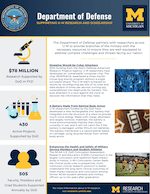Department of Defense

SUPPORTING U-M RESEARCH AND SCHOLARSHIP


$78 MILLION
Research Supported by DoD in FY21

430
Active Projects Supported by DoD

505
Faculty, Postdocs and Grad Students Supported Annually by DoD
The Department of Defense partners with researchers across U-M to provide branches of the military with the necessary resources to ensure they are well-equipped to address complex challenges and threats facing our nation.
Stopping Would-be Cyber Attackers
 With funding from the DoD’s Defense Advanced Research Projects Agency, U-M researchers have developed an “unhackable” computer chip. The chip, MORPHEUS, weathered a three-month virtual bug bounty program without a single successful attack. The U-M team achieved its results by reconfiguring key bits of its code and data dozens of times per second, turning any vulnerabilities into dead ends for hackers. This puts attackers in a race against the clock to discover the information that they need.
With funding from the DoD’s Defense Advanced Research Projects Agency, U-M researchers have developed an “unhackable” computer chip. The chip, MORPHEUS, weathered a three-month virtual bug bounty program without a single successful attack. The U-M team achieved its results by reconfiguring key bits of its code and data dozens of times per second, turning any vulnerabilities into dead ends for hackers. This puts attackers in a race against the clock to discover the information that they need.
A Battery Made From Retired Body Armor
 U-M researchers funded by the DoD have developed a new rechargeable zinc battery that integrates into the structure of a robot to provide much more energy. Made with cheap, abundant and largely nontoxic materials, the battery is more environmentally friendly than those currently in use, and it will not catch fire if the battery is damaged, unlike lithium ion batteries. The battery membrane is a nanomaterial based on cartilage, using recycled Kevlar from retired body armor.
U-M researchers funded by the DoD have developed a new rechargeable zinc battery that integrates into the structure of a robot to provide much more energy. Made with cheap, abundant and largely nontoxic materials, the battery is more environmentally friendly than those currently in use, and it will not catch fire if the battery is damaged, unlike lithium ion batteries. The battery membrane is a nanomaterial based on cartilage, using recycled Kevlar from retired body armor.
Enhancing the Health and Safety of Military Service Members and Student-Athletes
 The NCAA-U.S. DoD Concussion Assessment, Research and Education (CARE) Consortium is the largest concussion and repetitive head impact study in history. U-M’s Concussion Center leads the clinical study core, a prospective, multi-institution clinical research protocol to better understand the long-term clinical outcomes of head impact exposure and concussion among former NCAA student-athletes and military officers up to ten years after graduation.
The NCAA-U.S. DoD Concussion Assessment, Research and Education (CARE) Consortium is the largest concussion and repetitive head impact study in history. U-M’s Concussion Center leads the clinical study core, a prospective, multi-institution clinical research protocol to better understand the long-term clinical outcomes of head impact exposure and concussion among former NCAA student-athletes and military officers up to ten years after graduation.

